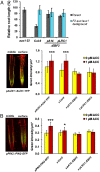The plant hormone ethylene restricts Arabidopsis growth via the epidermis
- PMID: 29643073
- PMCID: PMC5924893
- DOI: 10.1073/pnas.1717649115
The plant hormone ethylene restricts Arabidopsis growth via the epidermis
Abstract
The gaseous hormone ethylene plays a key role in plant growth and development, and it is a major regulator of stress responses. It inhibits vegetative growth by restricting cell elongation, mainly through cross-talk with auxins. However, it remains unknown whether ethylene controls growth throughout all plant tissues or whether its signaling is confined to specific cell types. We employed a targeted expression approach to map the tissue site(s) of ethylene growth regulation. The ubiquitin E3 ligase complex containing Skp1, Cullin1, and the F-box protein EBF1 or EBF2 (SCFEBF1/2) target the degradation of EIN3, the master transcription factor in ethylene signaling. We coupled EBF1 and EBF2 to a number of cell type-specific promoters. Using phenotypic assays for ethylene response and mutant complementation, we revealed that the epidermis is the main site of ethylene action controlling plant growth in both roots and shoots. Suppression of ethylene signaling in the epidermis of the constitutive ethylene signaling mutant ctr1-1 was sufficient to rescue the mutant phenotype, pointing to the epidermis as a key cell type required for ethylene-mediated growth inhibition.
Keywords: Arabidopsis; EIN3 binding F-box factor EBF; auxin; ethylene; root/shoot.
Copyright © 2018 the Author(s). Published by PNAS.
Conflict of interest statement
The authors declare no conflict of interest.
Figures







Similar articles
-
Ethylene signaling in Arabidopsis involves feedback regulation via the elaborate control of EBF2 expression by EIN3.Plant J. 2008 Sep;55(5):821-31. doi: 10.1111/j.1365-313X.2008.03551.x. Epub 2008 May 9. Plant J. 2008. PMID: 18466304
-
The Arabidopsis EIN3 binding F-Box proteins EBF1 and EBF2 have distinct but overlapping roles in ethylene signaling.Plant Cell. 2007 Feb;19(2):509-23. doi: 10.1105/tpc.106.048140. Epub 2007 Feb 16. Plant Cell. 2007. PMID: 17307926 Free PMC article.
-
ETHYLENE-INSENSITIVE5 encodes a 5'-->3' exoribonuclease required for regulation of the EIN3-targeting F-box proteins EBF1/2.Proc Natl Acad Sci U S A. 2006 Sep 5;103(36):13286-93. doi: 10.1073/pnas.0605528103. Epub 2006 Aug 18. Proc Natl Acad Sci U S A. 2006. PMID: 16920797 Free PMC article.
-
Genetic basis of ethylene perception and signal transduction in Arabidopsis.J Integr Plant Biol. 2008 Jul;50(7):808-15. doi: 10.1111/j.1744-7909.2008.00710.x. J Integr Plant Biol. 2008. PMID: 18713391 Review.
-
Seedlings Transduce the Depth and Mechanical Pressure of Covering Soil Using COP1 and Ethylene to Regulate EBF1/EBF2 for Soil Emergence.Curr Biol. 2016 Jan 25;26(2):139-149. doi: 10.1016/j.cub.2015.11.053. Epub 2015 Dec 31. Curr Biol. 2016. PMID: 26748855 Free PMC article. Review.
Cited by
-
Arabidopsis TBP-ASSOCIATED FACTOR 12 ortholog NOBIRO6 controls root elongation with unfolded protein response cofactor activity.Proc Natl Acad Sci U S A. 2022 Feb 8;119(6):e2120219119. doi: 10.1073/pnas.2120219119. Proc Natl Acad Sci U S A. 2022. PMID: 35115407 Free PMC article.
-
Acetoin Promotes Plant Growth and Alleviates Saline Stress by Activating Metabolic Pathways in Lettuce Seedlings.Plants (Basel). 2024 Nov 26;13(23):3312. doi: 10.3390/plants13233312. Plants (Basel). 2024. PMID: 39683105 Free PMC article.
-
Nuclear pyruvate dehydrogenase complex regulates histone acetylation and transcriptional regulation in the ethylene response.Sci Adv. 2024 Jul 26;10(30):eado2825. doi: 10.1126/sciadv.ado2825. Epub 2024 Jul 26. Sci Adv. 2024. PMID: 39058774 Free PMC article.
-
Phosphorylation status of Bβ subunit acts as a switch to regulate the function of phosphatase PP2A in ethylene-mediated root growth inhibition.New Phytol. 2022 Dec;236(5):1762-1778. doi: 10.1111/nph.18467. Epub 2022 Sep 26. New Phytol. 2022. PMID: 36073540 Free PMC article.
-
Ethylene Signaling Is Required for Fully Functional Tension Wood in Hybrid Aspen.Front Plant Sci. 2019 Sep 26;10:1101. doi: 10.3389/fpls.2019.01101. eCollection 2019. Front Plant Sci. 2019. PMID: 31611886 Free PMC article.
References
-
- Yang SF, Hoffman NE. Ethylene biosynthesis and its regulation in higher plants. Annu Rev Plant Physiol. 1984;35:155–189.
-
- Kieber JJ. The ethylene signal transduction pathway in Arabidopsis. J Exp Bot. 1997;48:211–218. - PubMed
-
- Kieber JJ, Rothenberg M, Roman G, Feldmann KA, Ecker JR. CTR1, a negative regulator of the ethylene response pathway in Arabidopsis, encodes a member of the raf family of protein kinases. Cell. 1993;72:427–441. - PubMed
-
- Vandenbussche F, Vaseva I, Vissenberg K, Van Der Straeten D. Ethylene in vegetative development: A tale with a riddle. New Phytol. 2012;194:895–909. - PubMed
Publication types
MeSH terms
Substances
LinkOut - more resources
Full Text Sources
Other Literature Sources
Molecular Biology Databases
Research Materials

